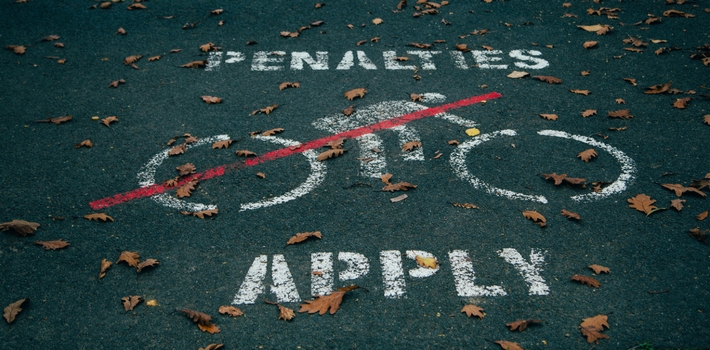Welcome to Part 4 in our series What To Do About Bad-Paying Customers. So far we’ve covered what actually makes customers ‘good’ or ‘bad’, what escalating your chasing is and when you should escalate for best results, and finally the three methods you can use to carry it out.
This week we’re taking you to the end of the line. When all other options have failed, you have three last resorts. Ladies and gentlemen - The Nuclear Options.

Go big or go home
When you’ve done everything you can to get an invoice paid - before due chasing, after due chasing, phone calls, changing your tone, escalating your senders and receivers - sometimes there will still be customers who just won’t budge.
If you’re completely confident the question of an invoice getting paid is when, not if, you’re still best suited continuing with polite, persistent chasing. But if the tables have turned and the question is resoundingly if, not when, it’s time to pull out all the stops.
The reason we call these the nuclear options is simple - executing any of these is highly likely to severely, and potentially irreparably damage, the trading relationship you have with the customer in question.
With that in mind, there are varying levels of severity to these options. From least to most severe, you have at your disposal:
- Sending debt collectors
- Charging late payment penalties and interest
- Legal proceedings
It goes without saying that these options should never be considered for Superstar Customers. Only the most severe PITA Customers, whose pain is becoming unbearable, should have you considering any of these.
Of course, another important element to consider before we delve into each of the options is the power dynamic you have with your customer. If you have a slew of competitors with similar offerings and your customer’s cost of switching is low, executing a nuclear option is more likely to lose your customer than if you blow your competitors out of the water, or fortuitously have very few competitors and there is a high cost of switching. Regardless, never underestimate the damage to a relationship a nuclear option has.
Now let’s dig in and take a closer look at what each of these options entails, when to use them, and what to expect if you use them.
Sending debt collectors
The least severe of your nuclear options, engaging debt collectors can be an effective way to get your invoice paid with least risk of losing your customer - although don’t underestimate, this risk is still high.

There are two key advantages to sending debt collectors:
- No win, no fee policies - Not universally applicable to all agencies, but it’s not uncommon for debt collectors to charge you zero fees if they do not collect the debt. Although this is great in terms of financial risk removal, be aware that fees collected on successfully recovered debts are often in excess of 25% of the invoice value, sometimes even approaching 50%.
- Separation - When engaging a debt collection agency to recover an unpaid invoice, it’s easy and not unreasonable to tell your customers something along the lines of “unfortunately, due to our internal processes, we’ve now had to pass over this invoice to a debt recovery agency…” All following communications with that customer regarding the unpaid invoice will be between them and the agency, leaving you separated from the actions and the “blame.” This can sometimes be enough to leave the (arguably challenging) road open to repairing the relationship in future.
Despite the separation advantage, when you’re looking for a debt collection agency it’s important you understand very clearly the process they undertake in recovering the debt. If you aren’t comfortable with their practices, you could completely snuff out any lingering chances of repairing the relationship with your customer.
Another important check to make before pushing the button on debt collectors is their reputability. Dodgy agencies do exist - beware suspicious fees, county court judgements, and operations without appropriate licensing.
Charging late payment penalties and interest
Taking it up a notch from debt collectors, charging late payment penalties and interest is the next most severe nuclear option in dealing with bad-paying customers. Many countries have legal frameworks in place to allow late commercial payments to be charged interest, and lump sum penalties to account for the costs in recovering the debt.
Before pushing the button on this option, carefully consider the benefits gained from charging late payment penalties and interest against the huge impact it will have on the relationship you have with the customer in question. You should only execute late payment penalties and interest if you’re happy with the outcome potentially being losing them as a customer.

If you’re okay with the drawback, let’s ponder the gain quickly - although it differs by country and territory, the rate of interest and monetary size of penalties you can legally charge are likely to be relatively low. In the UK, for example, invoices over £10,000 cannot be charged any more than £100 as a late payment penalty. If you can settle the unpaid invoice amicably and retain their business, you could earn many many multiples of these late payment fees in future revenue.
If, however, the customer relationship has completely broken down with repairability slim-to-none (and, let’s face it, to get to this point this is quite likely), it’s well worth tacking on late payment penalties and interest to the maximum amount - this is going to be the last money you ever get from them anyway. This is doubly true for customers going into administration.
Legal proceedings
Is this it? The wretched customer who absolutely, positively just won’t pay you? It’s no secret - threatening legal action against your customer is the most severe of the nuclear options and is really the final straw in getting bad-paying customers to cough up.

When you’ve done everything you possibly can to no avail, sending your customer a formal threat of taking legal action against them is the big one. Keep in mind that not only will this absolutely blow apart your customer relationship, it can have a hefty impact on the wallet too. Even if you can find someone to work for you on a no win, no fee basis, there are likely to be court charges you might not be able to recuperate. Make sure to take this into account and weigh up whether the potential return from getting the invoice paid still leaves you in the black after deducting the operational and legal costs in pursuing it.
Crunch has put together a credit control guide with a great summary of legal proceedings that I highly recommend you check out. Download it here and scroll to page 11 for the lowdown.
How to push the button
So you’ve considered all of the above, made up your mind, and you’re ready to go forward with one of the nuclear options. How do you carry it out?
If we look back over the master timeline of chasing again - before due email chasers, after due email chasers, phone calls, tone change, senders and receivers both escalated - there’s (usually) one thing missing; letters. While some see it as a slow and outdated medium of communication, a physical letter holds a level of formality other mediums don’t quite reach. When you’re delivering a nuclear option to a customer, you want to use the most formal vehicle available to you - a physical letter.

Within the letter you should document, at a high level, the complete chasing history (which you should keep consolidated and well-maintained) - reference all chasing dates, mediums of chasing, and any promised payment dates your customer provided you. This letter should succinctly summarise the history of the invoice’s life.
Segue from this into an explanation that you’ve exhausted your internal processes and can do no more to get this paid - hence why you’re executing a nuclear option. Finish off with a final payment date and the action (i.e. nuclear option) you’ll be taking if they fail to make payment - 7 to 10 days is the sweet spot.
Once you’ve posted the letter, immediately reach out to the customer with an email explaining this, attaching a copy of the letter sent - you don’t want them trying to turn the tables on you by claiming they never received your letter in the post.
Up next...
We’re approaching the end of our journey exploring What To Do About Bad-Paying Customers, but the ride isn’t over yet! In next week’s post, we wrap up the series with our top tips on how to turn bad customers good.
Sign up below so you don’t miss out on essential content to improve your finance function.




